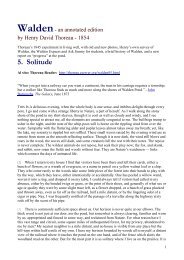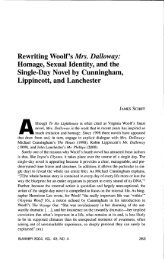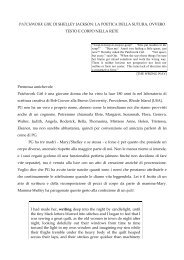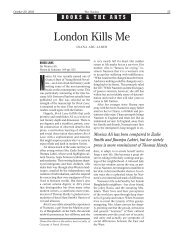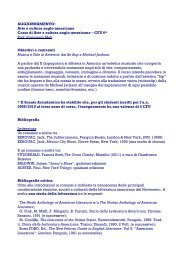Exciting Tales of Exotic Dark India - Paola Carbone
Exciting Tales of Exotic Dark India - Paola Carbone
Exciting Tales of Exotic Dark India - Paola Carbone
You also want an ePaper? Increase the reach of your titles
YUMPU automatically turns print PDFs into web optimized ePapers that Google loves.
276 Journal <strong>of</strong> Commonwealth Literature<br />
After decades <strong>of</strong> cashing in on the fascination with a mystical Eternal<br />
<strong>India</strong>, the idea <strong>of</strong> an ostensible <strong>Dark</strong> <strong>India</strong> has been acquiring <strong>of</strong> late<br />
a significant exotic cachet in the cultural industries. The representation<br />
<strong>of</strong> a <strong>Dark</strong> <strong>India</strong> is admittedly not new – it can be traced back to Mulk<br />
Raj Anand’s groundbreaking novels Untouchable (1935) and Coolie<br />
(1936). 2 Nonetheless, a revamped portrayal <strong>of</strong> a <strong>Dark</strong> <strong>India</strong> garnered an<br />
unparalleled visibility in 2008 with the award <strong>of</strong> the coveted Man Booker<br />
Prize for Fiction to Aravind Adiga’s debut novel The White Tiger. 3 The<br />
then Chair <strong>of</strong> the Booker judging panel, former British Cabinet Minister<br />
and Conservative MP Michael Portillo, celebrated the novel as “an<br />
intensely original book about an <strong>India</strong> that is new to many <strong>of</strong> us”. He<br />
further hailed it as “in many ways perfect” and added that the novel had<br />
“knocked [his] socks <strong>of</strong>f”. 4 Looking at The White Tiger from a parallel, but<br />
opposite angle, Somak Ghoshal wrote that Adiga’s narrative “turns out<br />
to be the ideal rough guide to <strong>Dark</strong> <strong>India</strong>: a series <strong>of</strong> extensive footnotes<br />
for the benefit <strong>of</strong> Western readers”. “As Adiga shows”, the <strong>India</strong>n critic<br />
contended, “the best bet for all those closeted novelists lurking in this<br />
country <strong>of</strong> a billion, is to write about the <strong>Dark</strong>ness, the rural hinterland<br />
that lies stashed far away from the dazzling <strong>India</strong> <strong>of</strong> the big cities.” 5<br />
Judging from the title <strong>of</strong> the novel, the reader might reasonably expect<br />
to encounter a tale about a rare and exotic character; furthermore, given<br />
that the tiger is a symbol <strong>of</strong> power and might, the title The White Tiger<br />
also alludes to <strong>India</strong>’s rise as a tiger economy, and thus conflates ideas <strong>of</strong><br />
exoticism and unstoppable economic growth. This article joins in the ongoing<br />
critical debate as to whether Adiga’s metaphorical construct <strong>of</strong> a <strong>Dark</strong><br />
<strong>India</strong> undermines previous stereotypes associated with the representation<br />
<strong>of</strong> a magical Eternal <strong>India</strong> and at the same time <strong>of</strong>fers a corrective portrait<br />
<strong>of</strong> the “progress” resulting from the <strong>India</strong>n IT and business outsourcing<br />
boom, or whether his novel is yet another covert way – through the use <strong>of</strong><br />
extremely effective self-reflexive representational strategies – <strong>of</strong> selling<br />
a refurbished exotic idea <strong>of</strong> the subcontinent to western readers. In this<br />
respect, a critical approach to the impact <strong>of</strong> The White Tiger in the western<br />
literary marketplace might well be induced by a question that the <strong>India</strong>n<br />
writer K. R. Usha poses in her review <strong>of</strong> the novel: “To whom is Adiga<br />
addressing this unleavened story, in his faultless prose” The answer is<br />
seemingly quite obvious for the author, considering that “[a]ny <strong>India</strong>n<br />
who reads the newspaper knows that <strong>India</strong> isn’t shining.” 6<br />
Against this backdrop, the broad purpose <strong>of</strong> this article is to examine<br />
Adiga’s staging <strong>of</strong> a <strong>Dark</strong> <strong>India</strong> as a new-fangled object <strong>of</strong> exoticist<br />
discourses. In The Post-Colonial <strong>Exotic</strong> (2001), one <strong>of</strong> the main points<br />
Graham Huggan makes is that <strong>India</strong> as exotic spectacle has progressively<br />
become available for global consumption. Through his formulation <strong>of</strong> “the<br />
postcolonial exotic”, Huggan critiques “the global commodification <strong>of</strong><br />
Downloaded from jcl.sagepub.com at Senate House Library, University <strong>of</strong> London on November 29, 2010



